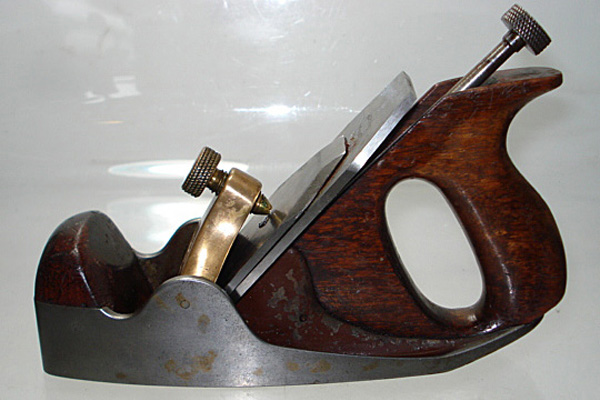
In the last years of the 19th century and a decade or so into the 20th century it must have been very obvious to the manufacturers of infill planes that the American “Stanley-type” planes were grabbing a large portion of the British cabinetmaker’s market (not to mention the markets in “The Colonies”). Way too much of the market in fact. With this in mind several makers decided to do something about it, albeit with varying results.
While none were able to break the Stanley Tools juggernaut, it’s safe to say that out of all the makers Thomas Norris was arguably the most successful — due primarily to an ingenious, if somewhat problematic, adjustment mechanism that controlled not only the depth of the cutting iron but its lateral movement as well. And all in the one unit.
Norris first patented the design in 1913, though the 1914 catalogue only showed the new adjusters in the No.50, No.52 and No.53 planes. In 1923 a modified version of the adjuster was patented, followed by a further modification sometime in the 1930’s.
Now I have to say at this point that I do admire the Norris adjuster. It’s clever, elegant and generally well made — but it does have its issues. I’m not that concerned that the forward/backward movement is finer (re: slower) than that of a Stanley-type plane. Stanley’s are workhorses so a quick adjustment is important. Infill planes, on the other hand, are thoroughbreds — primarily used to take the final swipes of the face or edge of a board. The main concern with these adjusters is that of wear, and subsequent backlash, of the adjustment mechanism — which unfortunately is more than that of a typical Stanley-type plane.
But enough of the adjuster, let’s get to one of the planes which featured it.
The Norris Number 50 “ordinary” iron smoothing plane was Norris’s attempt to get an infill-like handplane at a much cheaper price than their top-of-the-range dovetailed planes or lesser quality annealed iron infills. Only trouble was that it was still way too expensive than a Stanley-type plane (and, interestingly, the same price as a Norris Number 12 annealed iron smoothing plane in 1914). By the 1928 catalogue, however, there was a distinct price difference between the Number 50 and the Number 12 but, by then, there were three different cutter sizes — 2″, 2-1/8″ and 2-1/4″.
A gunmetal version (No. 50G) with a steel faced sole was also available, along with a malleable iron version (No. 50M). Interestingly enough there was no “A” proceeding the number, indicating that it was fully adjustable in the 1914 catalogue. By the time the 1928 catalogue was released, however, the No. 50M had become simply the “No. A50 annealed iron smoothing plane”.
As far as design elements go the Number 50’s all share a common pattern. Instead of a rear infill. the rear handle is sandwiched between two metal bosses which form part of the casting. These bosses also form the bed of the plane. Sometimes the mounting holes for the handle create a weakness in the casting which may result in cracking or breakage at this point. Not so with this particular plane, however.
The rear, or heel, of the casting is open with a gentle upsweep toward the handle from the sole, while the toe is fully enclosed. The rear handle itself is also of the fully enclosed variety. The front bun is a no-nonsense affair. The choice of woods used were rosewood (in the earlier planes) and stained beech wood in later planes such as the one featured here. I’ve also seen planes in which a mahogany-type wood (possibly padauk or “English mahogany”) is used.
The burgundy /brown paint on the inside rear of the casting of this plane is original.
While not grabbing enough of the market to compete with cheaper smoothing planes, the No. 50’s must have done fairly well for themselves, as there are certainly a few of them around. Though clearly not quite as good as their fully infilled and dovetailed cousins, at the end of the day they hold up quite well for themselves. Having a good, thick blade is a major asset here, even if a somewhat miniscule bed surface is, by the same token, a considerable weakness.
If you wish to know more about the Norris adjuster just follow the link.











